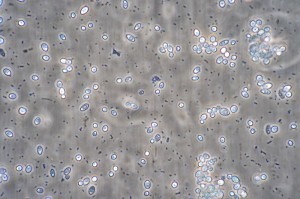
The main contributors to mould and bacterial growth are nutrients, temperature and moisture. Therefore, the elements of control, which can be used to preserve produce quality and reduce the impacts of microbial growth, are:
• Temperature • Moisture • Microbial control
The efficacy of ChillSafe can be enhanced by combining it with MoistureGuard as the control of water activity (relative humidity) provided by MoistureGuard in the cool room limits the opportunity for mould and bacteria to grow and as a consequence the ROS vapours released from the ChillSafe sachet are utilized more effectively in the cool room.
Mould
 Moulds are a type of non-chlorophyll-bearing plant. Moulds are able to thrive in an environment with a temperature range of (25–30C), but can also grow at slightly cooler or warmer temperatures. Moulds are usually aerobic and can tolerate a fairly wide pH range, but most moulds prefer an acidic ph. In breweries mould can thrive anywhere there is a little bit of moisture and a food source in open air. Moulds may be encountered on damp walls and floors, inside less-than-clean bottles and kegs, or almost any place where beer residue may be present.
Moulds are a type of non-chlorophyll-bearing plant. Moulds are able to thrive in an environment with a temperature range of (25–30C), but can also grow at slightly cooler or warmer temperatures. Moulds are usually aerobic and can tolerate a fairly wide pH range, but most moulds prefer an acidic ph. In breweries mould can thrive anywhere there is a little bit of moisture and a food source in open air. Moulds may be encountered on damp walls and floors, inside less-than-clean bottles and kegs, or almost any place where beer residue may be present.
Contamination
 Contamination affects the quality of the beer. Most contaminants will produce off-flavours, acids and non-desirable aromas. They can also produce hazy beers and films. They may compete with the production strain for essential nutrients; they can also induce stuck fermentation or over-attenuated beers. There are two major groups of microorganisms responsible for contaminating wort and beer:
Contamination affects the quality of the beer. Most contaminants will produce off-flavours, acids and non-desirable aromas. They can also produce hazy beers and films. They may compete with the production strain for essential nutrients; they can also induce stuck fermentation or over-attenuated beers. There are two major groups of microorganisms responsible for contaminating wort and beer:

